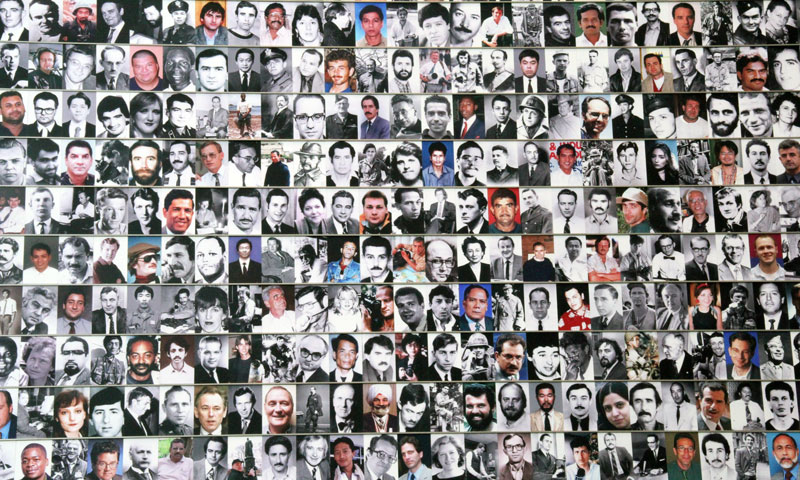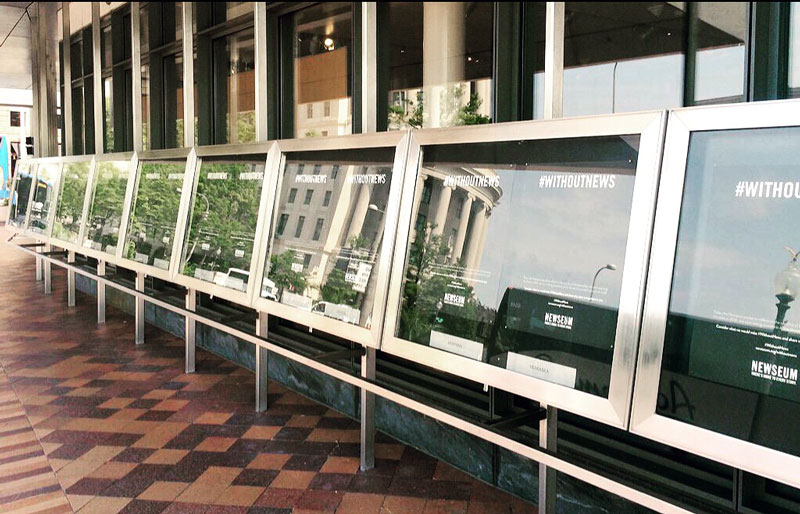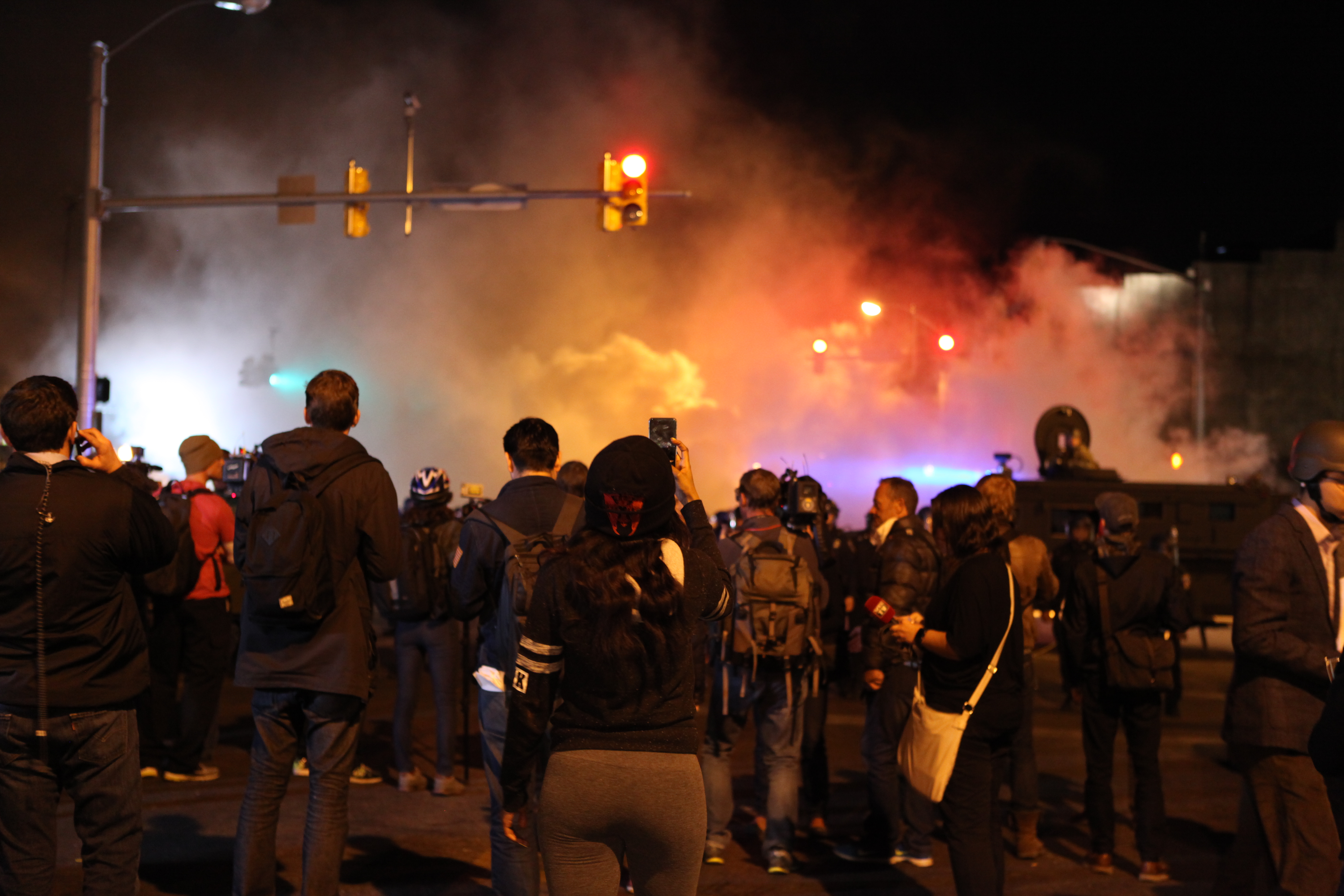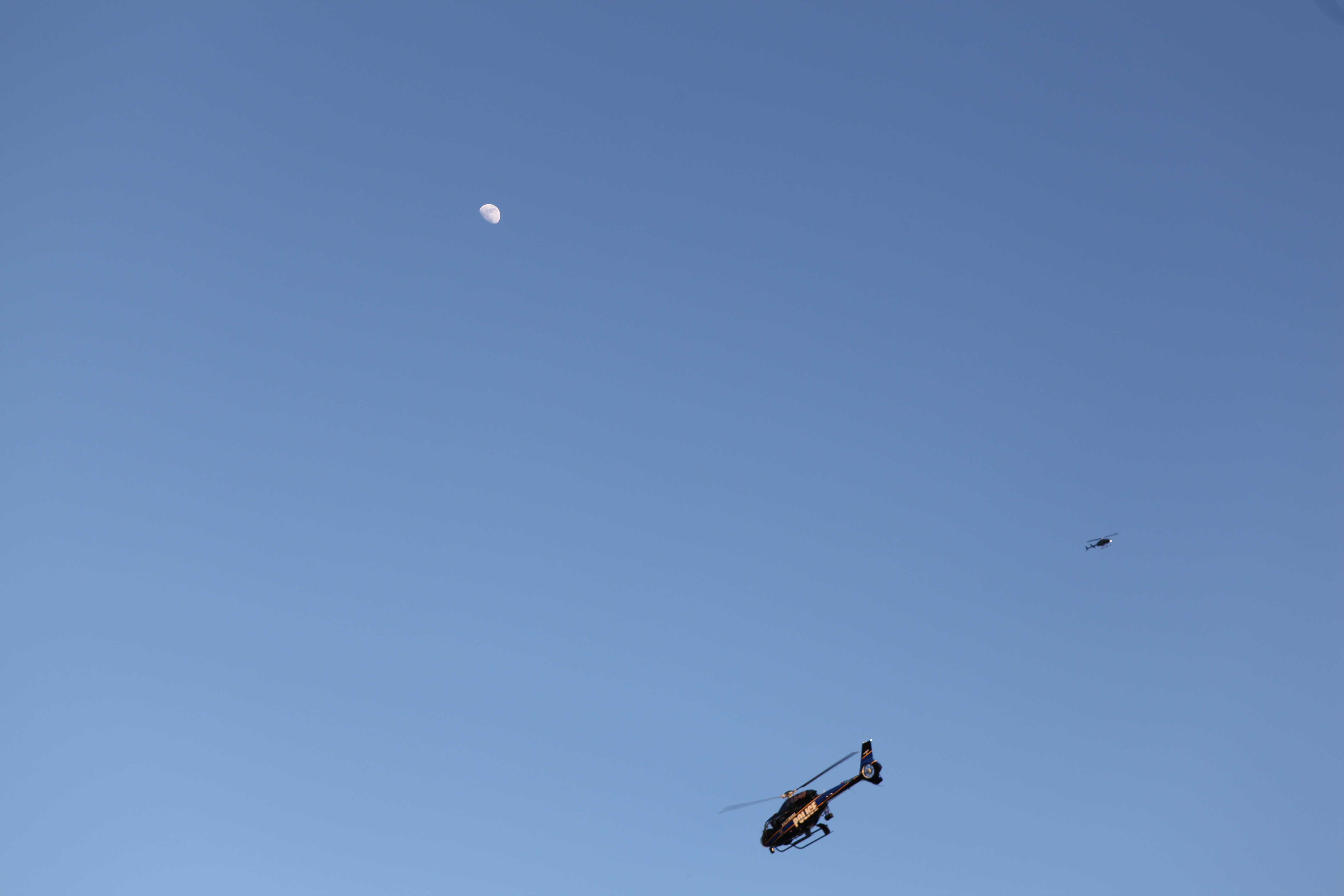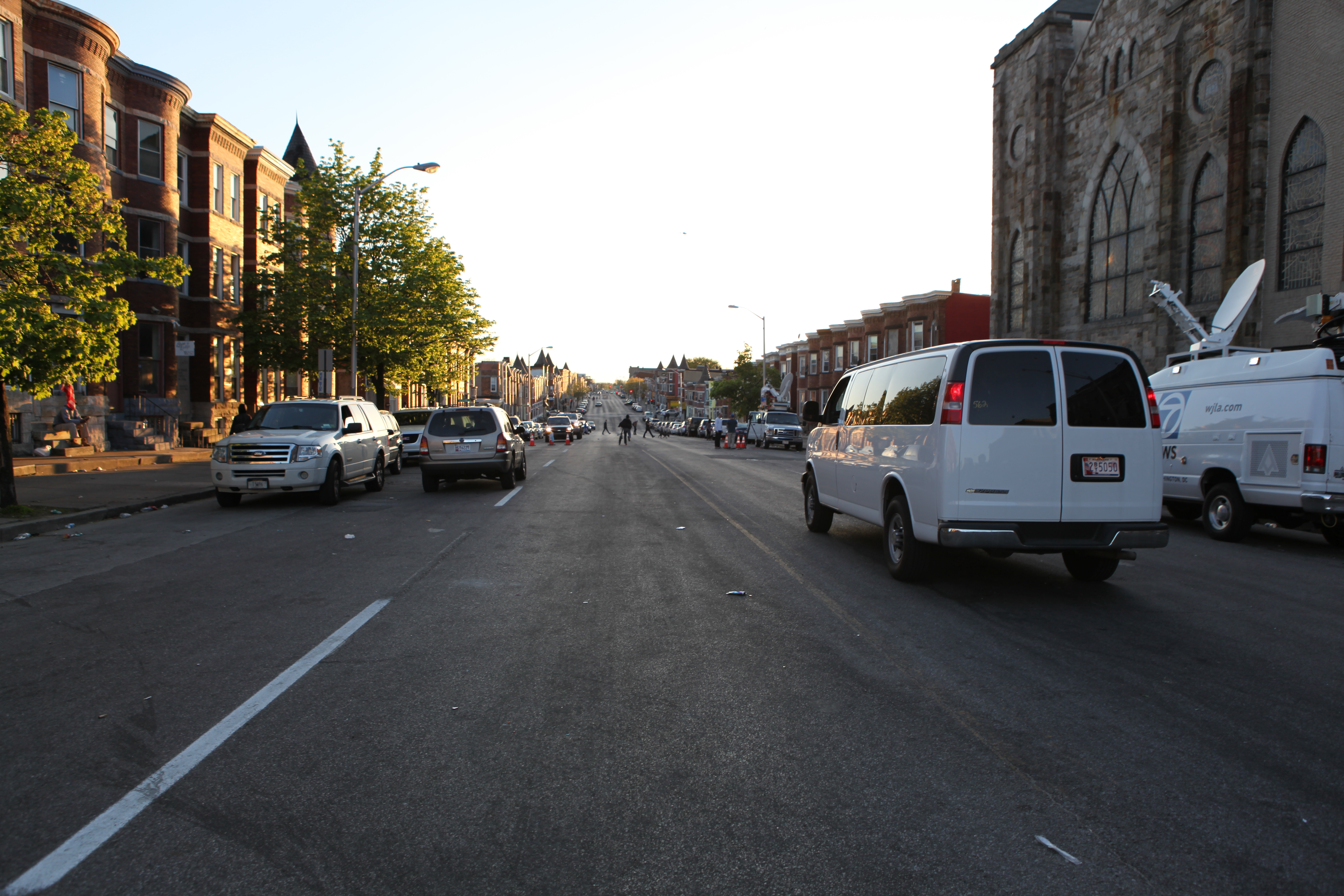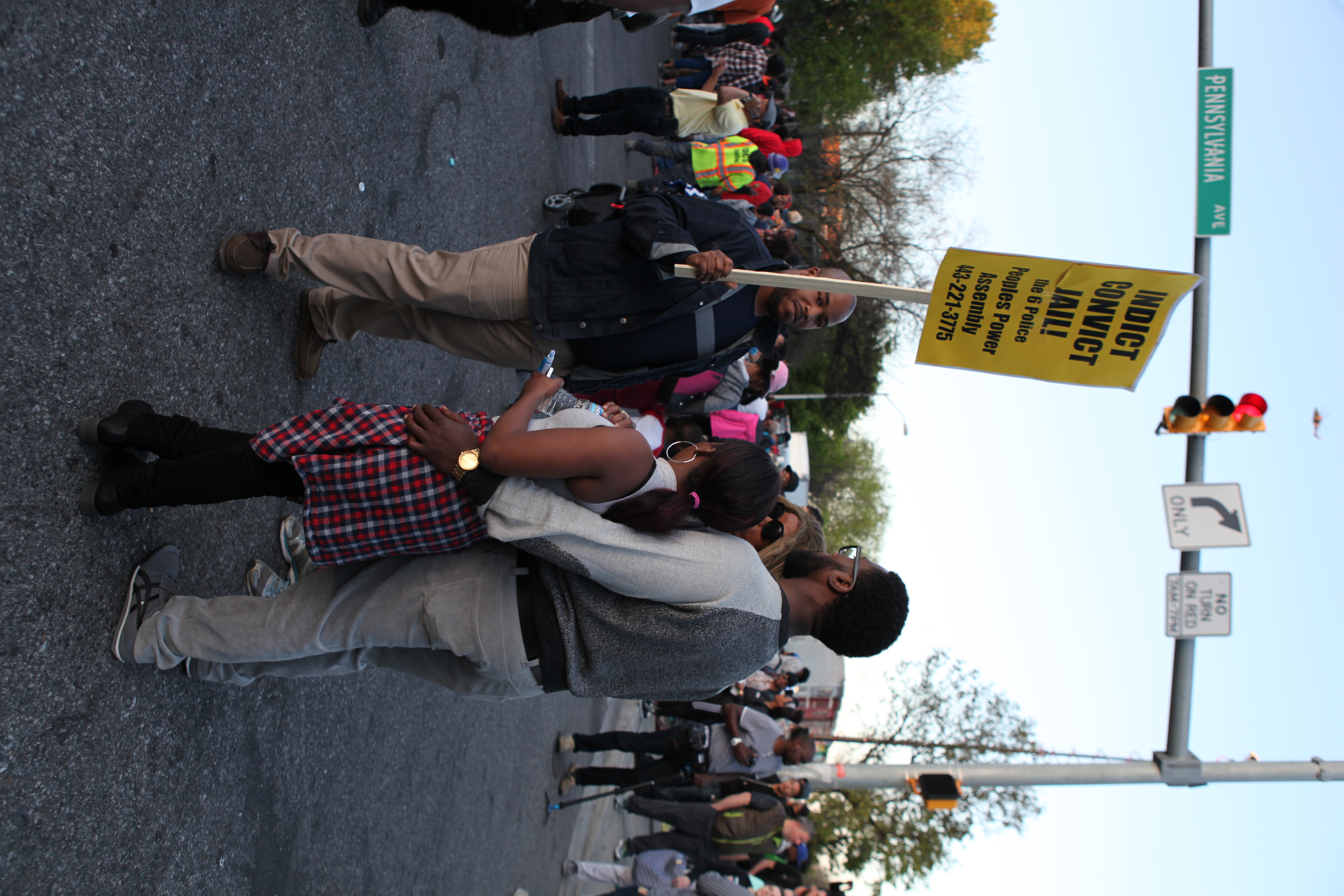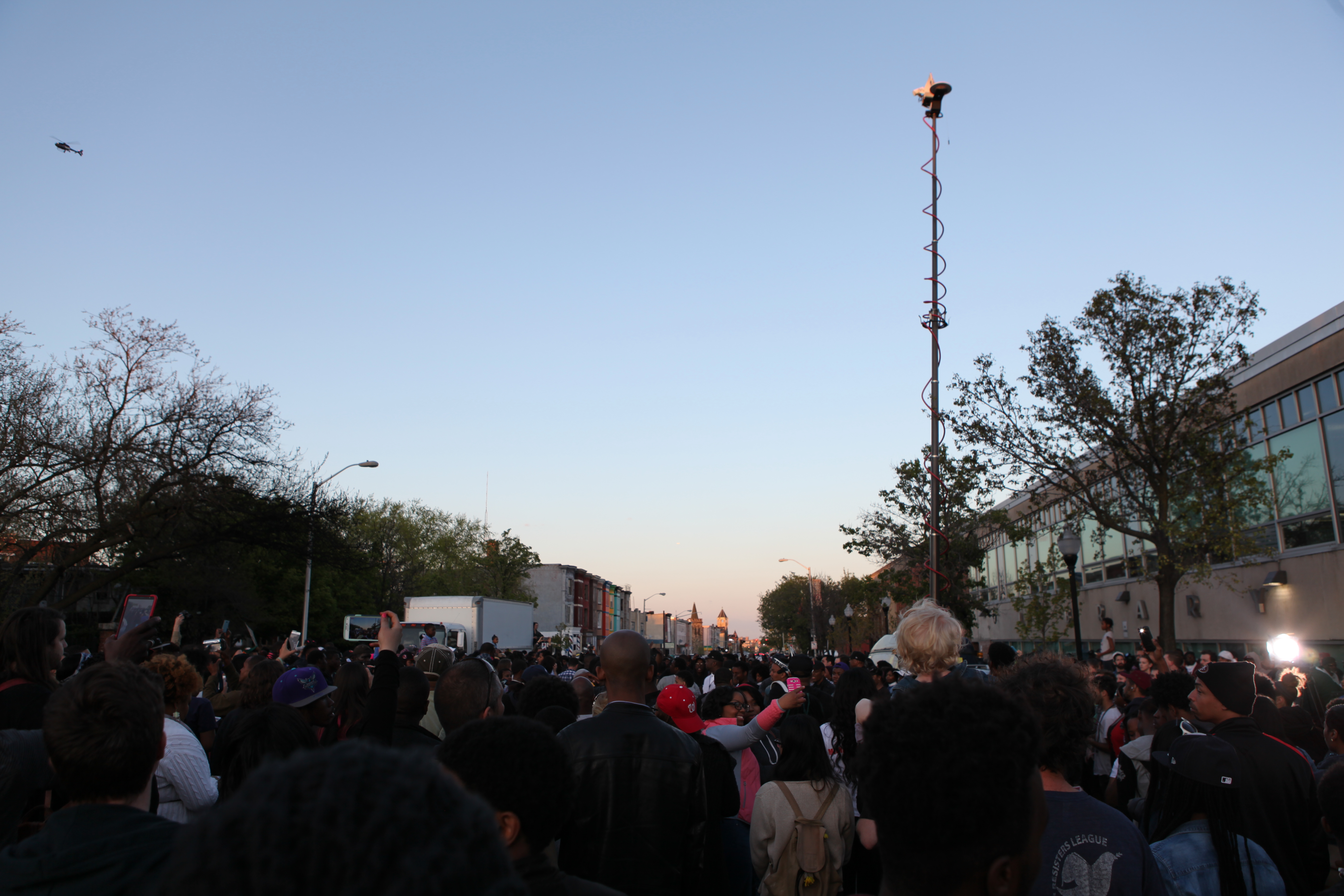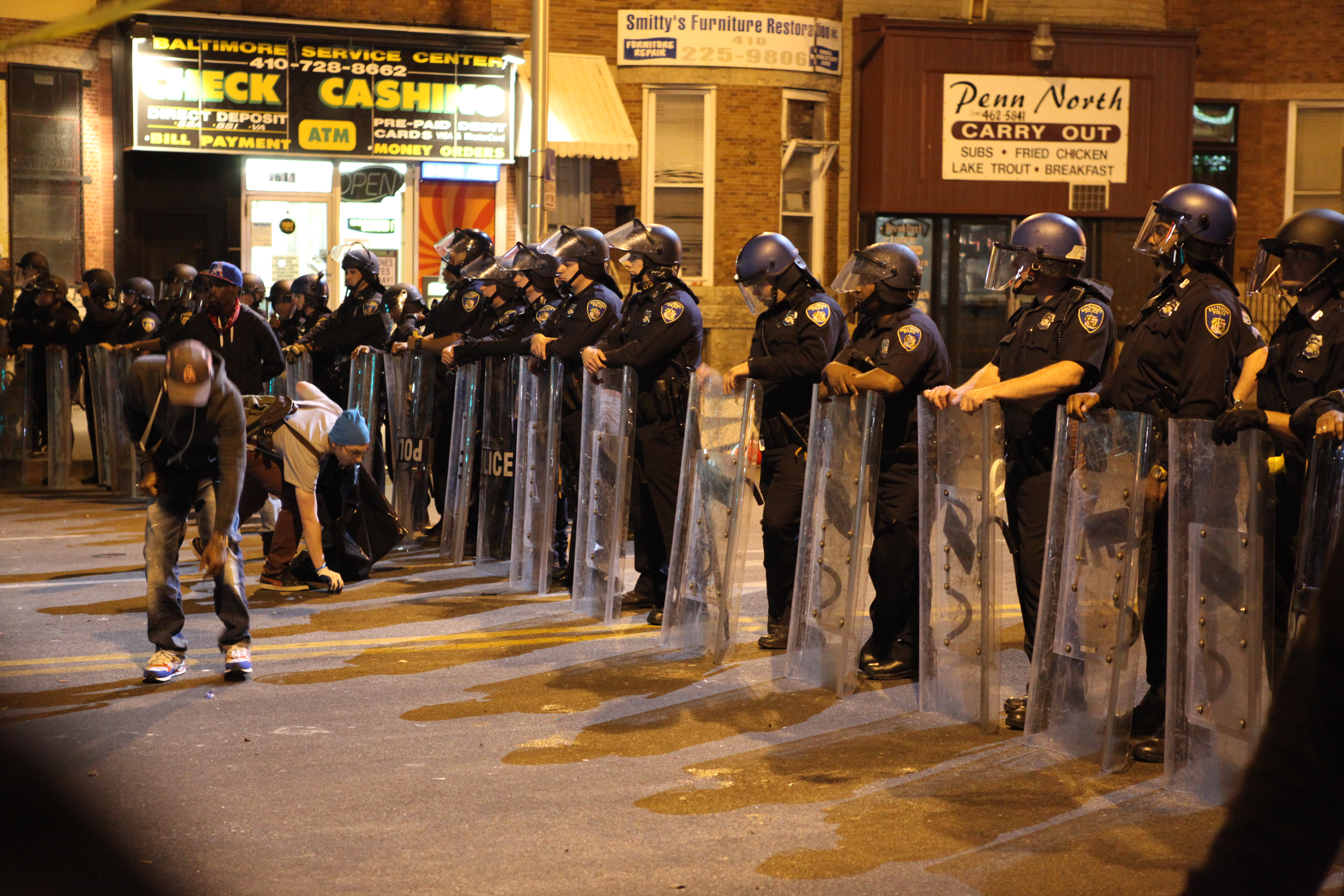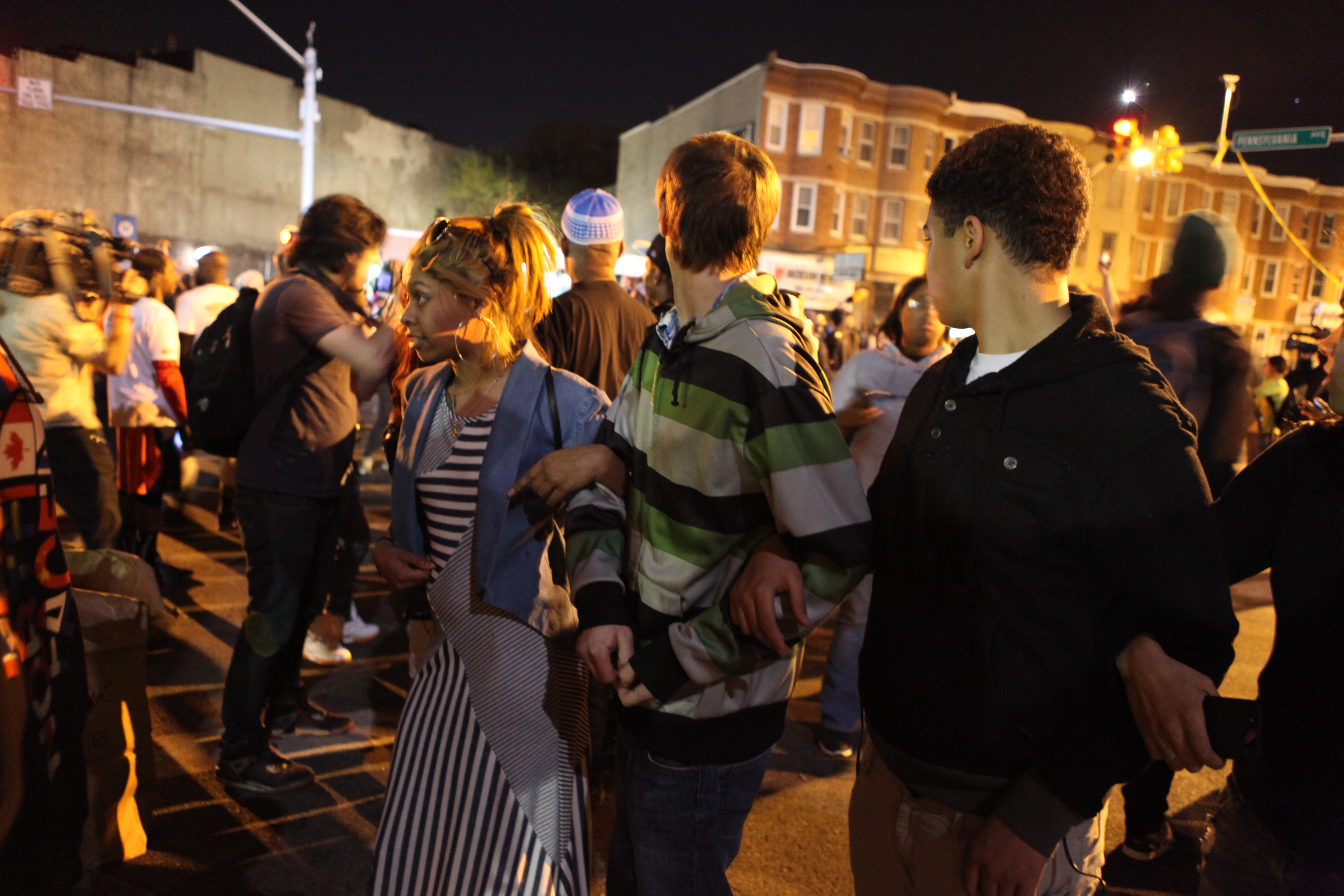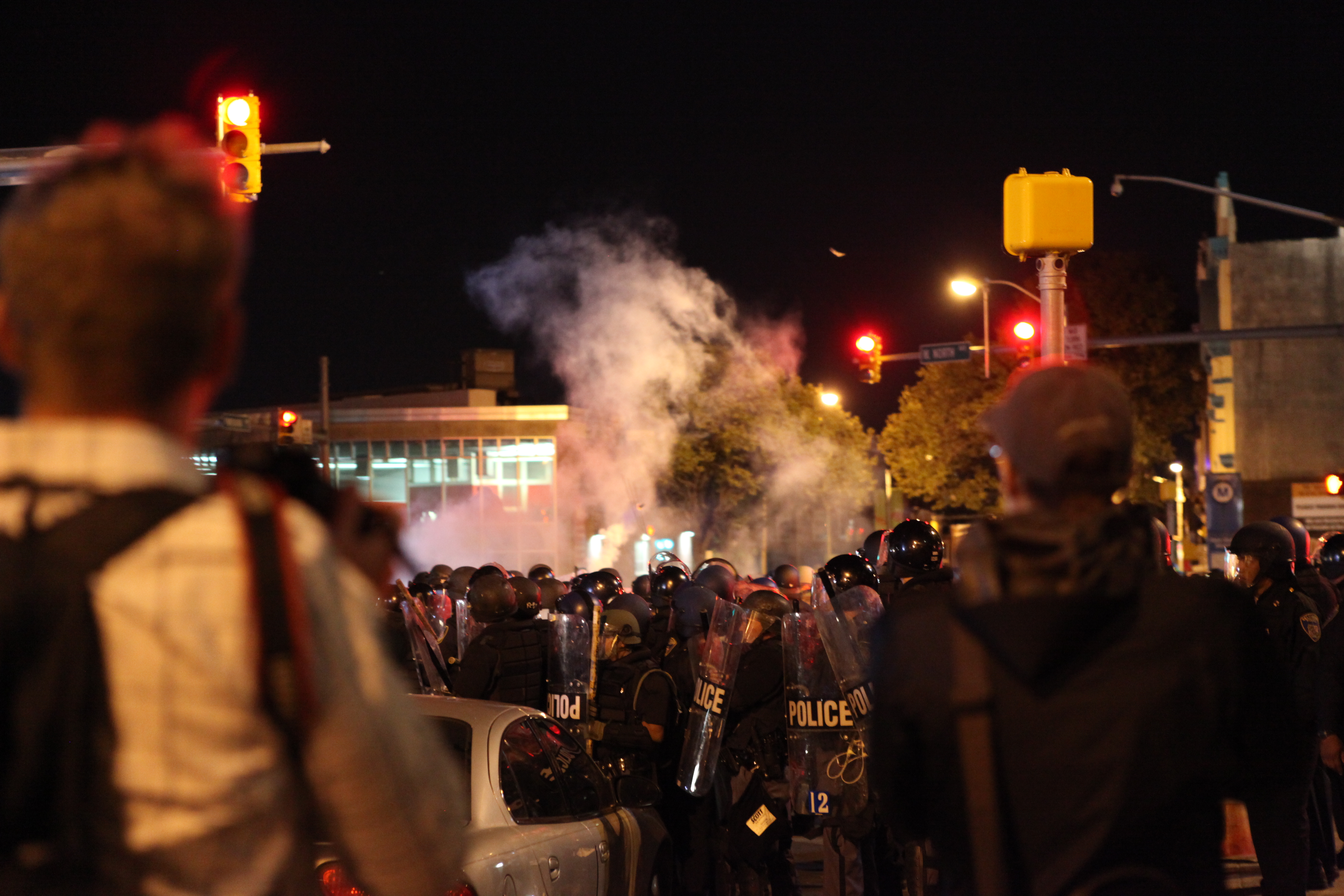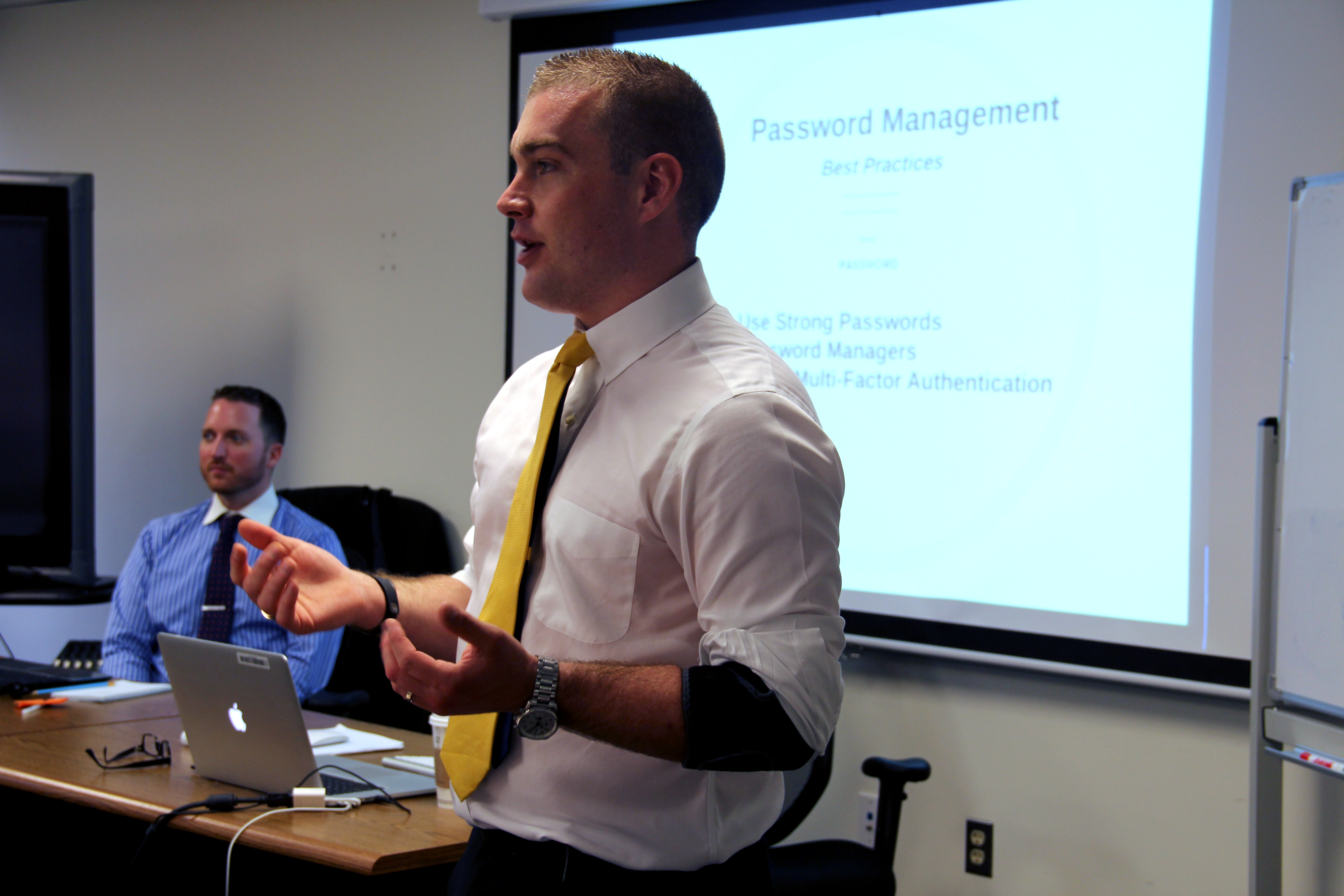Reporters, photographers and other journalists rarely receive formal training on how to cover urban protests and demonstrations. Usually they rely on the collected wisdom of colleagues who have had earlier experiences, some as recent as last year’s tension and violence in Ferguson, Missouri.
Now with the current demonstrations and violent protests in Baltimore following the death in police custody of 25-year-old Freddie Gray, another collection of journalists, young and old, is witnessing and learning what it means to cover unrest in one of the nation’s larger cities.
The lessons can be hard, the anxiety high and the consequences fearsome, so I went cautiously into the fray of Baltimore neighborhoods Tuesday to get a feel for the situation awaiting journalists on the ground and to gather reporting advice from veteran journalists, along with cautionary tips from military and community leaders. I was joined by Medill reporters Matt Schehl, Beth Lawrence and Zachary Vasile, who were also covering the tensions.
Here are some thoughts based on our observations and interviews that will help navigate reporting on often-violent street protests that can be as confusing as they are dangerous.
1. Don’t go it alone.
While flaming police cars and flying bricks tend to be the exception rather than the rule when it comes to covering protests, the whole “safety in numbers” maxim still applies.
The ability to operate across a variety of media is all well and good, but when time is of the essence and deadline is nearing, picking a niche at which you can excel can make the difference between a good story and a great one.
If you are a print journalist, it helps to be paired with a photographer. If you work in video, it helps to have a sound person. Regardless of how you mix-and-match your group’s components, having two (or more) players on your reporting team will increase your level of safety, help you fact-check details observed on the ground and allow you to focus wholly on your work within a single reporting medium versus trying to be a one-man band.
It’s also vital to set a rallying point before the start of an event – and especially a demonstration – where your reporting team can meet if anything goes awry. That way, even if your phone chargers die and you get separated in a large crowd, you can use that landmark as a point of reference for the sake of safety.
“Have a buddy and know where you parked your car,” says Reuters News Agency video producer Zachary Goelman.
2. Realize that the media is not a welcomed guest by everyone in the Baltimore community.
Two negative schools of thought regarding the media are gaining traction there.
The first is that the media has no place at peaceful demonstrations because it is sensationalism-obsessed, and, so, citizens assume that we’ll be disappointed unless we have a riot to show for our attendance and, therefore, we tend to tell unbalanced stories.
The second is that the media’s mere presence at demonstrations exacerbates tensions between civilians and law enforcement and essentially eggs the latter on, so an absence of media would result in increased peace between cops and the community.
While both of these points are worth considering, they also put journalists at risk of bodily harm or other types of harassment. It’s important to realize that clear communication can help build the missing trust.
Introduce yourself and your organization. Be open to hearing out subjects’ perspectives and building a story around them vs. trying to illicit responses that fit within a predetermined angle. Above all, treat your story subjects with respect and courtesy, and treat each introduction and interview as a human – rather than a business – transaction.
3. Understand preexisting biases.
Recognize that racial tension is high and many people may be reluctant to speak with reporters of any color. In the eyes of many local citizens, the Freddie Gray case is as much about race as it is about law-enforcement accountability.
4. Bring (or rent) a car.
You cannot rely on just Baltimore’s public transit system, the geography of the Freddie Gray story is wide and its major flash points may change quickly. Hopping in a car is much more time-efficient on deadline. If you’re car-less or can’t afford a rental, Uber is the next best thing. Wait times on Tuesday tended to be in the 3-5 minute range, and we didn’t pay more than $10 to get anywhere.
5. Pack the right equipment.
On Tuesday evening, the police-press dynamic at the protest around the intersection of West North and Pennsylvania avenues in Baltimore became very hostile, very quickly. Tear gas and smoke both came into play, in addition to projectiles being tossed by protestors at cops.
I didn’t bring a helmet, but I did bring a painter’s respirator (~$30 at Home Depot) just in case. I thought I was being paranoid, but soon as smoke appeared at Tuesday night’s protest and then saw other journalists donning gas masks and respirators of their own, I was glad I did.
Jeff Abell, a journalist with Baltimore Fox affiliate WBFF TV, advises journalists to keep a safe, reasonable distance from tear gas when it is deployed because the wind can carry the chemical your way even if you aren’t the intended target.
“If you’re out of sight, you’re gonna be out of mind,” he says.
Goelman, the video producer from Reuters, suggested packing “a bicycle helmet if you have it, a respirator if you can find one, some sort of eye protection” and “clothes you don’t mind donating” in addition to your normal reporting equipment.
And on a tech note, bring backup power for your backup power. Portable power sources run from about $5 (~one full smartphone charge, but not necessarily as powerful after the first go round) to $40 (~3 full smartphone charges and a bit sturdier), and are necessary investments for anyone heading out to Baltimore.
Unless your news organization gives you a generator to bring with you, there are zero places to plug in on the street. While coffee shops can be good options under regular circumstances, nearly every single local business we came across was closing before sunset in order to ensure the safety of its employees in the midst of the demonstrations.
“I would pack as many chargers as you have as possible because you will go through all of them,” Abell says. “Be sure you have some power supply because it doesn’t matter, you know, how much you think you have — everybody’s been running out and trying to plug in wherever you can see a plug.”
Portable wi-fi is also a must, since the citywide curfew means that all businesses have to be shuttered by 10 p.m. and cellular signals have been markedly slow within Baltimore.
6. Don’t assume that rules automatically will apply to you.
The Baltimore Police Department tweeted out a clarification message for journalists about the citywide curfew that took effect Tuesday.
According to the message, anyone with credentials was exempt from the curfew.
However, during Tuesday’s protest, police in helicopters above the crowd and surrounding buildings repeatedly instructed members of the media to disperse or else risk arrest. Additionally, the Baltimore mayor showed up to personally urge journalists and protestors, alike, to go home prior to the curfew.
These warnings, combined with the threat of arrest against journalists who remained after the 10 p.m. cutoff, suggests that the curfew’s implementation is dynamic in practice. For this reason, we’d suggest any journalists covering demonstrations with a police presence to exercise an abundance of caution.
7. If you’re traveling with a camera, don’t stick it in anyone’s face without permission.
This should go without saying, but increasing tensions have resulted in increasing assaults on journalists within city limits – including equipment theft and physical assault – so no interview is worth testing the limits of the community’s patience.
8. Show up early and leave late.
Reporting days in Baltimore go by fast, so getting local by late morning or early afternoon will give you more time to scope out interviews with locals, arrange meetings with community leaders and more.
On the flipside, leaving late – especially from protests – can give you a feel for the police-civilian dynamics at play in communities or just give you an opportunity to follow up with someone whose perspective piqued your interest during an event.
“I would treat this as a story that moves on its own rather than one you can move in,” says Reuters’s Goelman. “I would rely on the media and the press relations office of the law enforcement institutions. Follow them on Twitter.”
9. Talk to the people in uniform.
On Tuesday, the Maryland National Guard, Maryland state troopers and Baltimore city police were scattered throughout the city in an attempt to maintain order. The average cop was carrying a gun, zip ties, a nightstick and a Taser gun, while military members were fully suited up and armed. While the equipment may look forbidding, it’s important to understand how law enforcement communication systems work.
Individual police officers usually are discouraged from speaking to the press, but members of the media can direct press requests for everything from interviews to ride-alongs to the department’s Public Information Officer, or PIO. From there, the PIO can route your request down the proper parts of the bureaucratic pipeline, and no one risks getting fired for talking to you.
Maryland National Guard Staff Sergeant Michael Davis, a Public Affairs Officer (PAO), said soldiers are generally briefed on what they are and aren’t allowed to discuss, so any soldier should, theoretically, be approachable by the public. However, he said, the standard practice is first to make a request of a military division’s PAO, but there won’t necessarily be a PAO with every group of National Guard soldiers.
“Most soldiers know what to say, what not to say,” Davis explained. “We’re not gonna give specifics about our mission [or] put ourselves in harm.”
According to Maryland National Guard Sergeant Adam Safley, soldiers are trained to know where to direct journalists to get the information they need. “If we can’t give you the answer, we’ll help you find the person that can give you the answer,” Safley says.
10. Realize that there is life (and news) after protests.
Media briefings with the mayor and police, prayer vigils and civic-action meetings are just a handful of entry points journalists could cover to expand the Baltimore dialogue past protests. The current controversy began with an arrest, injury and loss of life, so examining the systems at play in these respective stages of the Freddie Gray story – as well as the long-term impact of his death on his neighborhood and the greater Baltimore area – is crucial to telling it responsibly.
Hear what Deacon Kevin Underdue Sr., a Baltimore preacher, has to say on the subject:

